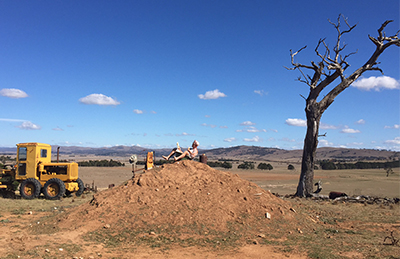Earlier this year, our Bachelor of Fine Arts (Design for Performance) students designed and directed a short film – Lobster Paradise – which premiered in the James Fairfax Foyer on Friday 30 September. Second-year student, Clare Staunton, shared her experience with us.

Earlier this year, our Bachelor of Fine Arts (Design for Performance) students designed and directed a short film – Lobster Paradise – which premiered in the James Fairfax Foyer on Friday 30 September. Second-year student, Clare Staunton, shared her experience with us.
It certainly isn’t every day you would be driving along a country road only to be waved around by students in fluorescent orange vests explaining that in fact a lobster in an urn, which two girls are carrying on their scooters, has right of way. It also certainly isn’t every day that you see these girls then scoot down a hill with a guy holding a camera towards them as he’s running backwards (to get a pretty great action shot as you can imagine), while the remaining crew are holding giant metallic reflectors to make sure our two stars Lucy De Hosson and Tamsin Van Gorp are perfectly lit in the light of a soon-to-be setting sun.
However, this was the experience for a few residents of Bungendore in April this year when NIDA’s Bachelor of Fine Arts (Design for Performance) second year (D2) and third year (D3) students shot their short film project – Lobster Paradise.
The film was conceptualised and designed by D3, with D2 art directing as well as co-ordinating the art department and costumes. This was then further divided into each of the six D3 students directing a scene and everyone being assigned to a role as crew when on set.
In its most basic form, the story follows the journey of two girls in their attempt to return a lobster they found, to where they believe it comes from. The script required the setting of a country town, plenty of which you can find if you drive a few hours far enough from Sydney, but Bungendore had something special – the wonderful home and property of Kate Davy, former Head of Technical Production and friend to Deputy Director and Head of Design for Performance Michael Scott-Mitchell. Kate’s generosity to house a very large group of designers, and essentially morph her place into a crazy hub of the unit base for the week-long filming made the experience much less demanding than it had the potential to be.
Filming off-site presented itself as one of the main and most rewarding challenges of this short film. Not only did everyone have to focus on getting the set, props and costume elements ready, we also had to ensure transport, catering, camping gear, lighting equipment and camera equipment (to name a few!) were all arranged before our journey began.
This was a great experience as everyone at one point or another took on a role which didn’t completely revolve around design, and we were all more focused on the logistical and practical nature of filming on location. In saying that, even though some of these tasks weren’t strictly in the realm of design, they were of course always done with the upmost theatrical flair and creativity. The task of catering, for example, quickly turned into a ritual of themed lunches and dinners prepared by designers not rostered on set that day, and were thoroughly enjoyed by all.
As well as having fun off set, there was so much to enjoy about making this film happen. Seeing the transformation of a location once it had been touched by the magic of the art department was incredible. From the transformation of an old commercial warehouse into the exterior of a Chinese restaurant to the creation of a contraption which ran along a rail line, there was never a dull day to be had on set.
It was rewarding constantly going through the creative process of experimentation and problem solving as different circumstances arose. One of the many comical moments was making a tumbleweed roll across a road on a day when there was no wind. One of the best attempts at this resulted in a priceless shot of a tumbleweed not in fact resembling any sort of tumbling action but instead sliding across the road as it was pulled by string. By take six, the tumbling action was resolved (with a different and much more advanced string pulling technique of course) and ended up looking very convincing, which everyone was happy with.
The process of constant on-the-spot problem solving on set was such a valuable experience during our time on location.
The filming continued for another week back at NIDA in the Parade Space where a studio set was created and also an evening shoot on location at the Mosman Rowers Club. Although not as full on as our previous week in Bungendore, there was still an assortment of different kinds of challenges. However after a week of perfecting the art of problem solving, the rest of the shoot went very smoothly.
Post-production involved D3 creating a rough cut of the film, which comprises syncing up the sound and dialogue recorded. They then sent their rough cut to external editor, Nicholas Lever, to create the final version. Sound design was done by NIDA tutor Kingsley Reeve; and an externalmusician,Declan O’Doherty, created asoundtrackfor the film.

